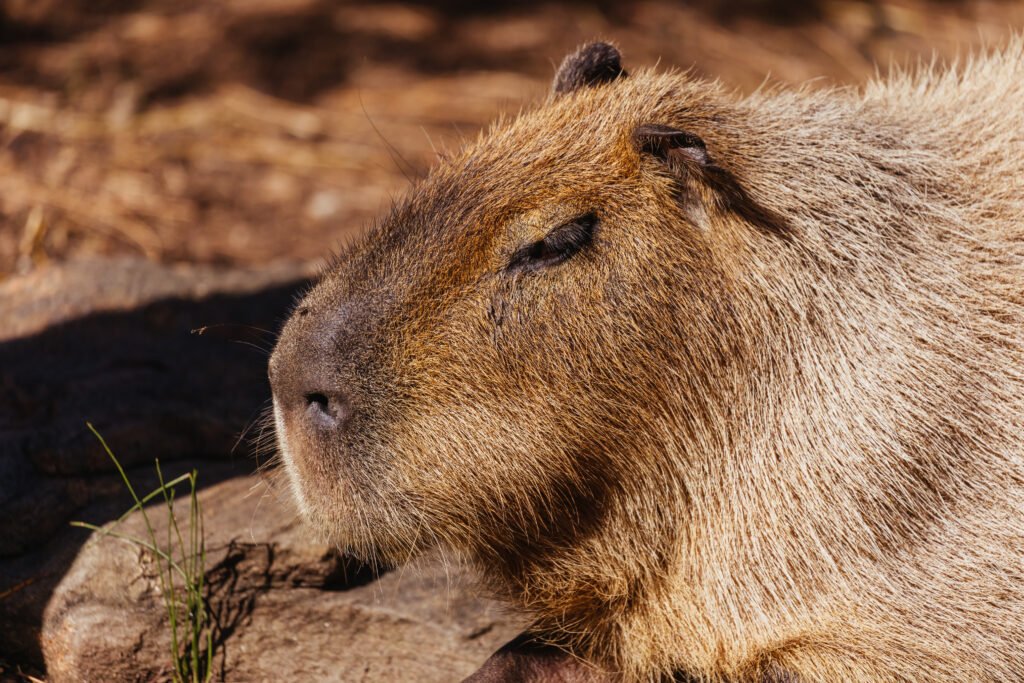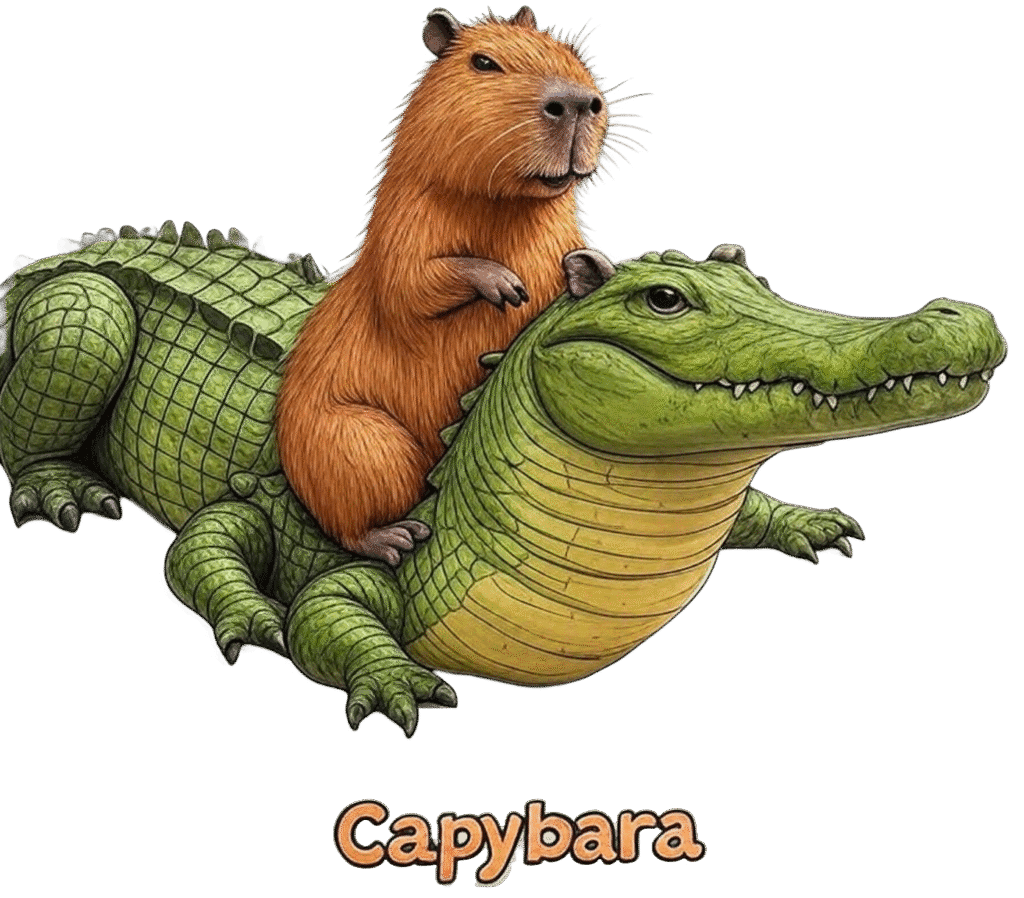20 Capybara Facts You've Never Heard Before
Updated August 8, 2025
With their perpetually relaxed demeanor and surprising friendships with other animals, the animal capybara has become a true internet sensation. These gentle giants, often seen lounging in hot springs or patiently letting birds perch on their heads, have captured the hearts of people worldwide.
But beyond their viral fame, these creatures hold a host of fascinating secrets.
You’ve seen the memes and the funny capybaras videos, but how much do you really know about the giant capybara? Get ready to become a true capybara expert as we dive into 20 facts that will make you appreciate this unique and wonderful rodent even more.
1. They Are the World’s Largest Rodent

Let’s start with the most famous fact. The capybara holds the title of the largest rodent on Earth. Fully grown adults can weigh as much as a human, reaching up to 170 pounds (77 kg) and measuring over 4 feet (1.3 meters) in length. This makes them a true “gentle giant” of the rodent world.
2. Their Name Means “Master of the Grasses”
The word capybara comes from the Tupi language, an indigenous language spoken in South America. It translates roughly to “Eater of the Thin Grasses,” a name that perfectly describes their primary diet and role in their ecosystem.
3. They Are Excellent Swimmers with Webbed Feet
Capybaras are semiaquatic mammals, which means they are just as comfortable in the water as they are on land. Their partially webbed feet act like natural flippers, allowing them to glide through water with ease. Their love for the water is why you often see videos of a capybara bath or them swimming alongside other animals.
4. They Can Sleep Underwater

This might be the ultimate testament to their aquatic lifestyle. Capybaras can hold their breath for up to five minutes, and they have the unique ability to take short naps in the water, with only their noses sticking out of the surface. This serves as a great way to escape the heat and hide from predators.
5. They Eat Their Own Poop (Yes, Really!)
Like rabbits, capybaras are coprophagous, meaning they eat their own feces. This isn’t a gross habit but rather a highly efficient digestive strategy. Their poop is rich in the microbes needed to fully break down the tough cellulose in the grasses they eat. By re-ingesting it, they get a second chance to extract all the vital nutrients.
6. Their Teeth Never Stop Growing
As with all rodents, a capybara’s large front teeth (incisors) continuously grow throughout its life. To prevent them from becoming too long, the animals constantly gnaw on tough grasses, aquatic plants, and even tree bark.
7. They Are Social and Live in Family Groups
Capybaras are highly social creatures that rarely live alone. They form herds, typically with 10 to 20 individuals, including a dominant male, several females, and their young. These strong social bonds provide protection and support for the entire group.
8. They Have a Highly Complex Vocal Repertoire
Capybaras don’t just purr. They use a wide variety of sounds to communicate with each other, including barks, whistles, chirps, clicks, and purrs. A warning bark, for example, is used to alert the group to potential danger from predators like jaguars.
9. Other Animals Use Them as “Moving Sofas”
Perhaps the most beloved thing about the capybara cute phenomenon is their willingness to let almost any animal, big or small, rest on them. It’s not uncommon to see birds, monkeys, and even other capybaras taking a rest on a larger capybara’s back. This behavior has earned them the nickname “Nature’s Ottoman.”
10. They are Friendly with Crocodiles and Alligators
You’ve probably seen viral pictures of a capybara and crocodiles or a capybara alligator in a pond. While it seems dangerous, capybaras have a famously peaceful relationship with these predators, often sharing the same watering holes. This is likely because the capybara’s large size and social group provide some deterrent, and they have a fast-running escape plan ready to go.
11. The Pope Once Classified Them as a Fish
During the 18th century, the Catholic Church in South America reportedly classified the capybara as a fish for religious purposes. Since they spend so much time in the water, the church ruled that their meat could be consumed on Fridays and during Lent, when the eating of land animals was forbidden.
12. They Have a Secret Scent Gland on Their Snout
Male capybaras have a large, prominent scent gland on their snout called a moroñcho. They use this to mark their territory and attract mates by rubbing the gland on grass and other objects. This scent helps them communicate their social status within the herd.
13. They are Surprisingly Fast Runners
Despite their barrel-shaped bodies and short legs, capybaras can be surprisingly quick on land. They are capable of running at speeds of up to 22 mph (35 km/h) to escape threats from land-based predators like pumas and jaguars.
14. They Need Water to Keep Their Skin Healthy
Unlike many mammals with oil-secreting skin glands, capybaras have very dry skin. To stay hydrated and healthy, they must spend a significant amount of time in water or mud. This is another reason why their semi-aquatic lifestyle is not just a preference, but a necessity.
15. They Can Experience a Rare Genetic Condition
While a rare sight, an albino capybara does exist. Albinism, a genetic condition that causes a lack of pigmentation, results in animals with white fur and pinkish eyes. An albino capybara is more vulnerable in the wild due to a lack of camouflage and sensitivity to sunlight, but they are a truly unique and beautiful sight.
16. Their Pups Are Highly Precocious
Capybara babies are born with a full coat of hair and can follow their mothers and graze on grass within a week of birth. They are weaned around 16 weeks, but even before that, they are often seen suckling indiscriminately from any of the mothers within their social group.
17. They Were Once a Symbol of Argentina’s Class Struggle
In a quirky 2021 incident, capybaras “invaded” a wealthy, gated community near Buenos Aires. The animals, reclaiming what was once their natural habitat, became a viral sensation and were adopted as an anti-capitalist symbol, with people jokingly calling them a “wildlife army” reclaiming their land. This is one of the more famous funny capybaras moments in recent history.
18. You Can Find a Christmas Capybara
While they aren’t native to the North Pole, capybaras are a huge hit in Japan, where they are known for their love of hot springs. During the winter holidays, many zoos and parks create christmas capybara hot baths by adding yuzu, a type of citrus fruit. The image of these serene animals relaxing with oranges on their heads is a staple of the holiday season.
19. A Capybara Pet Requires Special Care and Is Not for Everyone
Thinking about getting a capybara pet for sale? While their friendly nature is appealing, it’s crucial to understand the commitment. These are not domesticated animals, and they require a specific environment with a large space and access to a body of water. The capybara price can be significant, ranging from $1,000 to $3,000 or more, and that’s before factoring in their high capybara cost for food and specialized veterinary care. Furthermore, a capybara for sale is not legal everywhere, and you must check local laws before considering one.
20. There Are No Capybara Mexican Varieties
Capybaras are native to Central and South America, with their range extending north into Panama. While they are often associated with tropical climates, they are not found natively in Mexico. If you see a capybara mexican reference, it is likely a misunderstanding of their true geographic range.
From their surprising friendships with crocodiles to their role as a class struggle symbol, these fascinating facts prove that the capybara is much more than just a cute face. It’s a truly unique and complex animal capybara that deserves all the attention it gets.
